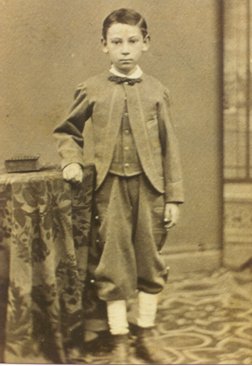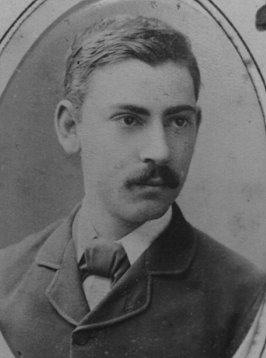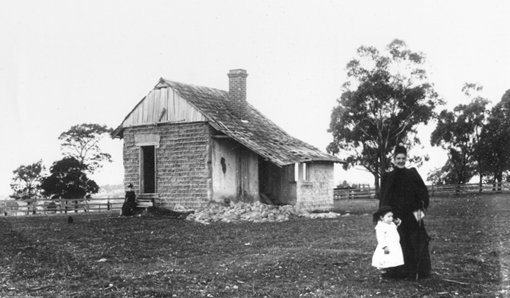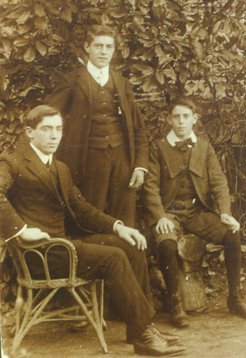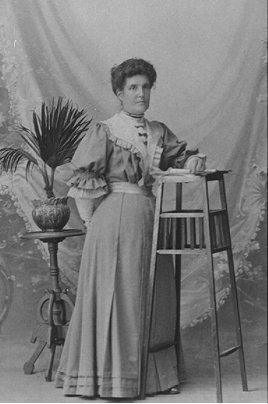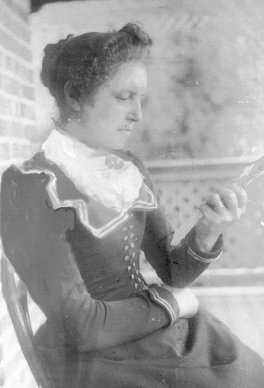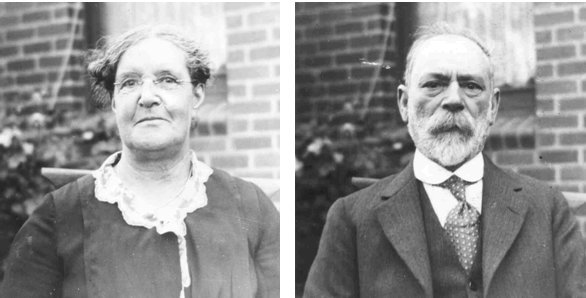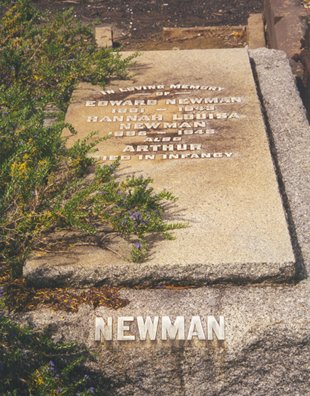Edward Newman - 1861-1942 |
||
|
Edward NEWMAN
Edward and Hannah Newman were my grandparents. The trouble with writing about my Grandparents is that I was only really with them much when I was a child and children tend to take people as they find them, without question, real thought or criticism and, in a way, without really noticing them. For children are essentially only interested in themselves, and everything and everyone around them is just peripheral to their lives. Even so I am sure I enjoyed being with Grandma and Grandpa, for I remember with pleasure when they took my sister Eileen and me away on holiday and when we stayed in their house, but can't say that I really knew them and of course I wish I had asked more questions. My grandfather (Grandpa), Edward Newman, was only four years old when his mother died. She was only twenty-six. She died of tuberculosis, or, as he called it, consumption. Grandpa was sent to live with his grandparents and was brought up by them. These must have been his mother's parents, Thomas and Mary Ann Raymond, as his paternal grandfather, Thomas Newman, had died in Marshfield, England before his father went to Australia and his paternal grandmother, Mary Ann Newman, died in 1855. Grandpa's Raymond grandparents very much missed England and used apparently to extol its virtues ad nauseam. This gave my grandfather a dislike of England, so much so in fact, that when he travelled in later life, he made sure he only came to England in the winter when he could dislike it with impunity. Grandpa was very proud of his mother's family, the Raymonds. He used to tell us that the Raymonds came to England with William the Conqueror which is possibly true as there was a Raymond in the Norman invading army. Grandpa's father, Edward Ford Newman, married again and he was never forgiven for it by Grandpa. Maybe this was due to the influence of his grandparents as he was hardly old enough to remember his mother. His father and Emma Jane, his second wife, had a daughter, Edith, but I gather that Grandpa would never have anything to do with her. It is interesting to note that it was my father who kept in touch with her (she was not much older than he), and he continued to visit and care for her in her old age right up to her death. |
||
| ||
|
| ||
|
Grandpa was a joiner and cabinet maker. I understand that in the depression in the 1890s things were pretty difficult for him and he took a job at Mt. Macedon where he was, I believe, cutting fence posts or something of that sort. It is possible that the picture below was taken during that time. In the foreground is Grandma, and the child is most likely my father (at that time boys wore dresses when toddlers). The very strange, unfinished little house in the background must have been where they were living. I expect that the figure sitting outside the door of the house must have been my Great Aunty Bess, Grandma's sister. | ||
|
| ||
|
When he became more prosperous Grandpa had a large joinery factory at the rear of his house. The whole property, house and factory, took up a double block between two streets. The house was on Carlisle Street, Hawthorn, and the factory on Westley Street. Between the two there was a fence with a gate in it. His office was in the house. As children we loved going into the office and twisting on the swivel chair. Amongst other things, he kept a stamp collection in the office, with a box of Victorian stamps. The office smelt of a special glue Grandpa used in his photographic work for he was a very keen photographer. He took endless pains to get a picture just right, often visiting a place over and over again in order to get the right light for a picture or to get some cows in the scene. He developed, printed and enlarged all his pictures himself in a small dark-room shed in the garden. After that a careful selection of pictures was made and he would mount them most beautifully between two pieces of heavy white paper, the front one being cut to reveal the picture. Each one was labelled with his meticulous print and the collection was bound in a leather binding. The shelves in his office had a row of these books, and it used to be a great joy to look at them. I am now the proud owner of one of them. Grandpa, like many of the Newman family, was born with itchy feet so he loved to travel. I remember once when we all went to see Grandpa and Grandma off on their travels, which of course in those days was by ship, from Port Melbourne. Everyone had streamers from shore to the passengers on the ship. It was a wonderful sight. As the ship moved off the streamers gradually broke. We children collected up armfuls of them and took them home. Most of Grandpa's wonderful books of photographs contained pictures he had taken in the countries he visited on his travels, Italy being his favourite. As well as inheriting his wanderlust, my father probably inherited his love of the Australian bush, which is also well represented in his photography. Grandpa may have been a little parsimonious, at least in Grandma's opinion. When they were on their travels they always stayed in the cheapest accommodation possible. Grandma longed to have a bit of luxury but I don't think she ever got it. When Grandpa died he didn't leave as much money as everyone expected, so perhaps he had every reason to be thrifty. As children we used to love to go into the joinery factory. It had this wonderful smell of wood and there was always a pile of sawdust to play with. I remember on one occasion that Grandpa made us yo-yos out of wood. Just outside the gate, on the house side, there was a big peppercorn tree which we loved to climb. In the house there was a picture of the organ in the Melbourne Town hall. I had always believed that Grandpa had made all the elaborate woodwork for the organ but have recently discovered that as he was in is late 60s at the time this work was done it was more likely to have been done by his son, Walter. However the name on the organ is E. Newman and Son and he was justifiably proud of it. He was very annoyed that the maker of the actual organ had his name plate in a prominent place on it, whilst Grandpa's name plate was in a less prominent position. In Grandpa's opinion, his work was the more important! | ||
| ||
|
and the three sons of Edward Newman and Hannah Newman. My father, Sydney William on the left of Leonard and Walter. | ||
|
From a websites I have found the following information:
When I knew them, Edward & Hannah Newman lived at 8 Carlyle Street, Hawthorn and this was where my father was brought up and where we used to go as a family on Sundays to visit. | ||
|
| ||
|
Through many years Grandpa had collected copies of an early illustrated Australian newspaper which he had had bound. As I grew up I used to love looking at these and reading the news items in them. In one of them there was the whole, blow by blow, story of Ned Kelly as it happened, in successive papers, his exploits and his final capture and trial. It was absolutely fascinating to read. The illustrations were not photographs but wonderfully detailed woodcuts, sometimes taking up a whole page. The work that was put into them was extraordinary. The ones I remember most were dramatic pictures of shipwrecks around some of the treacherous coast of Victoria. The artists had used their imaginations to the full. My sister Helen has the book which contains the story of Ned Kelly but I do not know who has the others. Another wonderful place to play in my grandparent's house was the cellar. This was a room under the back part of the house (the whole width of the house) which you entered down a flight of stone steps from the garden. It smelt of the apples and quinces which were stored there. There were also all sorts of interesting old bits of household equipment, for my grandmother had a great love of buying all kinds of newly invented gadgets. I wonder where they all are now? There was also stored furniture and trunks of clothes which we used for dressing up. In the garden there was a fish pond covered with wire netting. One of the other things that Grandpa did in the little shed where he used to develop his photographs was to grind up biscuits with a pestle and mortar for the fish. Like most things with Grandpa, this was a ritual. Sometime in his adult life Grandpa had had a blood clot and it was expected that it would travel to his heart and kill him. This did not happen but forever after he was very careful of bending as he felt that this had been the cause of the clot. I can see him now, carefully keeping his back straight and bending at the knees if he needed to pick something up from the floor. Another theory he had was about his eyes. He believed that if you did too much reading, your eyes would deteriorate, so he never read a book and only occasionally looked at the newspaper. He bathed his eyes religiously every day. When I knew him Grandpa had a full beard and he was always rather proud of the fact that on the ship that he went abroad on, he was mistaken for King George V. Jokingly they sang the National Anthem to him. A possession which was grandpa's pride and joy was his car, a Model T Ford. I can still see in my mind a vision of him and Grandma sitting up high and stiff in the front of this contraption. It was very high and had open sides. One of his sons, my Uncle Wally, had a sea-side house at Rye, a resort on Port Phillip Bay, and my sister, Eileen, and I were sometimes taken on holiday by Grandma and Grandpa to this house. The journey took us all day. I was absolutely amazed when, on a recent visit to Australia, I found that with modern cars you can go there, spend the day there and back all in one day. A memorable part of the journey was chugging up Mt.Eliza and, when we finally reached the top, seeing the bay spread out before us. It was a good holiday in the rather primitive little house surrounded by tea trees. Eileen and I used to play on the beach where Eileen once found a tiny wooden clog. When we were taken to the Back Beach we used to look for, and find, fossilised parts of trees which we later kept in a museum we made in the garage at home. I remember I once wandered off by myself and got lost for sufficient time to worry my grandmother sick and give me a great sense of importance. One day Grandpa actually paddled. I was shocked to see how white his legs were. Grandma - Hannah Louisa Newman, nee BULLEY Grandma and her sister, Aunty Bess, were the daughters of Louisa, nee Stevens the second eldest of the three sisters who their father, Charles Bulley, married before marrying his housekeeper. This last marriage was a great cause of bitterness to the children of the three sisters, who were all very close, as the last wife is traditionally believed to have brought six of her own, previously unknown children, into the home. She must have had a very strong influence over her husband as the girls in the first families were sent out into service, a great disgrace in a fairly well-to-do family. The prosperous family business, leather merchant shop and warehouse, were passed on to one of the children of the last wife jointly with one of his own sons but others of his sons were left out of his will altogether (as was my grandmother). | ||
| ||
|
Two early photographs of Hannah Louisa Newman, nee Bulley. I think that the one on the right was taken by my grandfather | ||
|
Grandma was a rather austere lady. Through a good deal of my father's childhood, Aunty Bess lived with the family and seems to have been quite a mother figure to him. She certainly had more of the gift to unbend than grandma. All the same I have the feeling that grandma had quite a sense of humour although a rather secret one. My father must have had someone to inherit his sense of humour from, and I don't think it would have been his father. When passport photographs were needed for my grandparents for their last trip abroad, my grandfather decided to do them himself. He snapped grandma and she him. She has a little twist of amusement on her face whereas he looks as if he wonders if she is capable of the job. The days of the week all had their special tasks in Grandma's life - washing on Monday etc. One of the days was baking day, Friday, I think, and on that day she would produce a large number of pies and cakes which would last for the week. The produce of the garden was used in the pies; apples, quinces and mulberries from the huge tree by the back veranda. Apple and blackberry pie was also a great favourite and I remember well going blackberrying with grandma. In fact I never do it now without thinking of her. | ||
|
| ||
|
The kitchen, in Grandma and Grandpa's house was a much lived in room and all meals were eaten there. It made my father determined not to do so when he had a home of his own. There was a dining room, but that was used more as a sitting-room, not dining. The dining room was full of large Victorian furniture. It contained a massive sideboard (with a china biscuits barrel on it) a very large square table and chairs and a couch and arm chairs. There was also a radio - crystal, I think. This was where they sat in the evening and where we all sat when the family visited on a Sunday. There was also a front parlour in the house but this room was only used if someone like the vicar visited. This room was furnished with very delicate, beautifully made little chairs and on the mantelpiece there were tiny cups and saucers and other ornaments which, on the few occasions that I was allowed into the room, I loved to look at. After Grandpa died, Grandma moved out of her house to go and live with Aunty Bess in St.Kilda. It was difficult to sell her big Victorian furniture and it all went for a song. The only member of our family who was interested in any of the furniture, because she was about to be married, was my sister, Win, and she only had one of the parlour chairs. What a waste! Grandma died in her 84th year. She went, as usual, to the Church of England in St.Kilda early one Sunday and sat in the front pew where she just quietly passed away. In her hand bag it was found that she had written out the name and address of my father who was to be contacted in just such a case. Grandpa had died in his bed, also in his 84th year. I am told that he had exerted himself cutting down a tree and had a heart attack. I remember that when my father came back home from seeing him after he had died, he said how peaceful his father looked. Farve was glad that he had seen him and said that it made one unafraid of death. | ||
|
| ||
|
In the probate papers with Grandpa's will there is an extra bit that says that his will was made in 1901 and kept in the house. Some months before his death he found that the will had been attacked by silverfish and some portions of it entirely destroyed. He mended it with gummed paper (in the presence of Grandma) with the intention of preserving it. Grandma had to testify that she believed that he regarded it as his will up to the time of his death. In the will he left the house in Carlyle Street and the joinery workshop (valued at £1200), another house in Hotham Street, Fitzroy (£1500) a small property in Harcourt Street, Hawthorn and personal property not exceeding £1339/12/4 entirely to his wife, my Grandmother, and she was the named executrix. Much against my father's will, as he would have liked his old home to be kept, the decision of his mother and brothers was that all the property should be sold. The house in Hotham Street, Fitzroy was bought from the estate by my father and given to my mother. At the time it was let at 35 shillings a week. I also have a copy of the will and probate of my grandmother, Hannah Louisa Newman. My father, Sydney William Newman was her executor and she left everything equally between her three sons. As well as some broaches and a pearl ring which I think belonged to Grandma or Auntie Bess I have a fob watch which has an inscription inside saying | ||
|
H A N N A H N E W M A N from HER FATHER 15th Sept.1886 | ||
|
The date was my grandmother, Hannah Newman's wedding day. Her father was Charles Bulley. I have recently been able to have a watchmaker restore it so that it works. They are all treasured possessions, especially the watch. I am told that the watch would have been worn on a long chain and tucked into a pocket at the waist. This particular kind of watch with the small glass in front is called a Half Hunter - a Full Hunter having no glass front at all. The watchmaker who restored it said that he was unable to get small indentations out of the gold case. He thought they looked like tooth marks. Was it given to my father and his brothers as a teething-ring!!? Edward Newman was the only son of Edward Ford Newman who was the only son of Thomas Newman. Edward and Hannah Newman have more than 100 living descendants today (2008) but none of them carry the NEWMAN surname because their three sons had daughters only. Therefore the NEWMAN name as a surname died out in this generation. We would have to go back to other sons of Elver Newman to find other Newman connections. |

